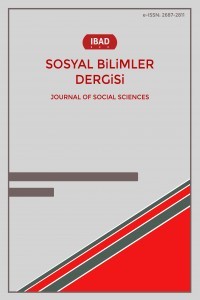KKTC'DE EVLİ BİREYLERİN EVLİLİĞE KARŞI TUTUMLARI, ÇATIŞMA VE ALDATMA EĞİLİMLERİNİN İNCELENMESİ
EXAMINING RELATIONSHIPS BETWEEN MARITAL ADJUSTMENT, TENDENCY FOR CONFLICT AND CHEATING AMONG MARRIED COUPLES
___
- References Allen, E. S. & Baucom, D. H. (2004).Adult attachment and patterns of extradyadicinvolvement.Family Process, 43(4), 467-488.Atkins, D.C., Baucom, S. & Jacobson, N.S. (2001). Why do people have affairs? Resent research and future directions about attributions for extramarital involvement. In V. Manusov & J. H. Harvey (Eds.), Attribution, communication behaviour and close relationships (pp.305-319). New York: Cambridge University Press.Atwood, J. D. & Seifer, M. (1997). Extramarital affairs and constructed meanings: A social constructionist therapeutic approach. American Journal of Family Therapy, 25(1), 55-75.Beach, S.R.H. &Tesser, A. (1988). Love in marriage: a cognitive account. In R.J. Stenberg & M. L. Barnes (Eds.), The Psychology of Love (pp.330-358). New Hevan, CT: Yale. Bonds-Raacke, J. M., Bearden, E. S., Carriere, N. J., Anderson, E. M. & Nicks, S. D. (2001). Engaging distortions: Are we idealizing marriage? Journal of Psychology, 135(2), 179- 184.Buunk, B. P., & Bakker, A. B. (1995). Extradyadic sex: The role of descriptive and injunctive norms. Journal of Sex Research, 32(4), 313-318. Burleson, B. R. & Denton, W. H. (1997). The relationship between communication skill and marital satisfaction: Some moderating effects. Journal of Marriage & the Family, 59(4), 884-902.Cramer, D. (2001).Consensus change, conflict, and relationship satisfaction in romantic relationships.Journal of Psychology, 135(3), 313-320.Cramer, D. (2003).Facilitativeness, conflict, demand, for approval, self-esteem, and satisfaction with romantic relationships.Journal of Psychology, 137(1), 85-98.Egan, V. & Angus, V. (2004).Personality and Individual Differences 36, 575–586.Erbek, E., Beştepe, E., Akar, H., Eradamlar, N. & Alpkan, R. L. (2005).Evlilik uyumu. [Marital Adjustment] Düşünen Adam, 18(1), 39-47. Dökmen, Ü. (1986). Yüz ifadeleri konusunda verilen eğitimin duygusal yüz ifadelerini teşhis becerisi ve iletişim çatışmalarına girme eğilimi üzerindeki etkisi [Tendency of Conflict] PhD dissertation,summary, Psikoloji Dergisi, 6, 21. Dökmen, Ü. (2001). İletişim çatışmaları ve empati [Conflicts in communication and emphaty]. İstan¬bul: SistemYayıncılık.Dökmen, Ü. (2002). İletişim Çatışmaları ve Empati. [Conflicts in communication and emphaty].İstanbul: SistemYayınlarıGordon, K. C., Baucom, D. H. &Snyder, D. K. (2004). An integrative intervention forpromoting recovery from extramarital affairs. Journal of Marital and Family Therapy,30(2), 213-232.Hamamcı, Z. (2005). Dysfunctional relationship belief in marital satisfaction and adjustment.Social Behavior and Personality, 33(4), 313- 328.Jones, G. D. & Nelson, E. S. (1997).Expectations of marriage among college students from intact and non-ıntact homes.Journal of Divorce & Remarriage, 26(1-2), 171-189. Kantarcı, D. (2009). Evli Bireylerin Bağlanma Stillerine Göre Adatma Eğilimleri Ve Çatışma Yönetim Biçimlerinin İncelenmesi [Examining conflict styles and tendency to cheat among married individuals in the context of attachment]. (Unpublished doctoral dissertation) Istanbul University, Istanbul.Koerner, A. F. & Fitzpatrick, M. A. (2002). You never leave family in fight: The impact of family of origin on conflict-behaviour in romantic relationships. Communication Studies,53, 234-251.McCubbin, H., Larsen, A., & Olson, D. (1987). F-COPES Family crisis oriented personal evaluation scales. In H. I. McCubbin & A. I. Thompson (Eds.).Family assessment inventories for research and practice (pp. 193-207). Madison, WI: University of Wisconsin –Madison.Lawson, A. & Samson, C. (1988).Age, gender and adultery.British Journal of Sociology, 39(3), 409-440.Locke, H. J., & Wallace, K. M. (1959). Short marital adjustment and prediction tests:Their reliability and validity. Marriage and Family Living, 21, 251–255.MacGeorge, E. L., Graves, A. R., Feng, B. & Gillihan, S. J. (2004). The myth of gender cultures: Similarities outweigh differences in men's and women's provision of and responses to supportive communication. Journal of Sex Research, 50, 143-175.Malkoç, B. (2001). İletişim şekilleri ve evlilik uyumu arasındaki ilişki [A relationship between communication styles and marital adjustment]. (Unpublished master’s thesis). Middle East Technical University, Ankara.Montgomery, B. M. (1981). The form and function of quality communication in marriage.Family Relations, 30, 21-30.Norment, L. (1998a). Infidelity: Why men cheat. Ebony, 54(1).Norment, L. (1998b). Infidelity II: Why women cheat. Ebony, 148.Polat, D. (2006). Evli bireylerin evlilik uyumları, aldatma eğilimleri ve çatışma eğilimleri arasındaki ilişkilerin bazıdeğişkenler açısından incelenmesi [Examining the relationships between marital adjustment, tendency to conflict and cheat in the context of several variables among married individuals]. (Unpublished master’s thesis) Ankara University, Ankara.O’Leary, K. D. & Smith D. A. (1991).Marital interactions.Annual Review of Psychology, 42, 191- 192.Olson, M. M., Russell, C. S., Higgins-Kessler, M. & Miller, R. B. (2002).Emotional processes following of an extramarital affair.Journal of Marital and Family Therapy, 28(4), 423-434.Özuğurlu, K. (1985). Evlilik raporu [The marriage report]. İstanbul: AltınKitaplarYayınevi.Tegin, B. (1990). Üniversite öğrencilerinin atılganlık davranış ve eğilimlerinin cinsiyet ve fakülte değişkenleri açısından incelenmesi [Examining the assertive behaviour in the context of gender and faculty related variables among university students]. PsikolojiDergisi, 7(25), 21-32.Sabatalli, R. M., Buck, R. & Kenny, D. A. (1986). A social relations analysis of nonverbal communication accuracy in married couples. Journal of Personality, 54 (3), 513-527.Sprecher, S. (1998).Social exchange theories and sexuality - the use of theory in research and scholarship on sexuality.Journal of Sex Research, 35(1), 32-43.Veroff, J., Young, A.M. & Coon, H.M. (1997).The early years of marriage.In S. Duck (Ed.) Handbook of Personal Relationships (2.ed), (pp.431-450). New York: Wiley.Zusman, M. E.,, Gescheidler, J., Knox, D., & . McGinty, K. (2003). Dating manners among college students. Journal of the Indiana Academy of the Social Sciences. 7, 28-32.
- Yayın Aralığı: Yılda 2 Sayı
- Başlangıç: 2016
- Yayıncı: Hayrullah KAHYA
BİTKİLERİN KÜLTÜREL ÇAĞRIŞIMLARI
Nilgün GÜNEROĞLU, Elif KAYA ŞAHİN, Elif AKTÜRK
GEÇİCİ KORUMA STATÜSÜNDEKİ SURİYELİLERİN KENTE UYUMU: ANKARA SİTELER’DE İSTİHDAMA KATILIM
Zeynep Aslı GÜREL ÜÇER, Seher ÖZKAZANÇ, Zeynep ATILGAN
LİSE MATEMATİK DERS KİTAPLARININ ÖĞRETMEN GÖRÜŞLERİNE GÖRE İNCELENMESİ: 10. SINIF ÖRNEĞİ
KAMPÜSLERDE YAYA VE BİSİKLET YOLLARINA UYGUN SÜRDÜRÜLEBİLİR DONATI TASARIM KRİTERLERİ
Banu Çiçek KURDOĞLU, Elif BAYRAMOĞLU, Sultan Sevinç KURT KONAKOĞLU
ORTAÖĞRETİM ÖĞRENCİLERİNE YÖNELİK ÖZEL DERS EĞİLİM ÖLÇEĞİNİN GEÇERLİK VE GÜVENİRLİK ÇALIŞMASI
ÇOCUKLARIN İZLEDİKLERİ ÇİZGİ FİLMLER VE BU TERCİHLERİNİNKARAKTERLERİ İLE İLİŞKİSİ
Lale CERRAH ÖZSEVGEÇ, Arzu SAKA
ETKİLEŞİMLİ TAHTA KULLANIMINA İLİŞKİN SOSYAL BİLGİLER ÖĞRETMENLERİNİN GÖRÜŞLERİNİN İNCELENMESİ
İhsan ÜNLÜ, Muhammed Fatih KIZILKAYA
DOĞAL ALANLARIN REHABİLİTASYON VE İYİLEŞTİRME ETKİSİNİN DEĞERLENDİRİLMESİ: EYMİR GÖLÜ, ANKARA ÖRNEĞİ
